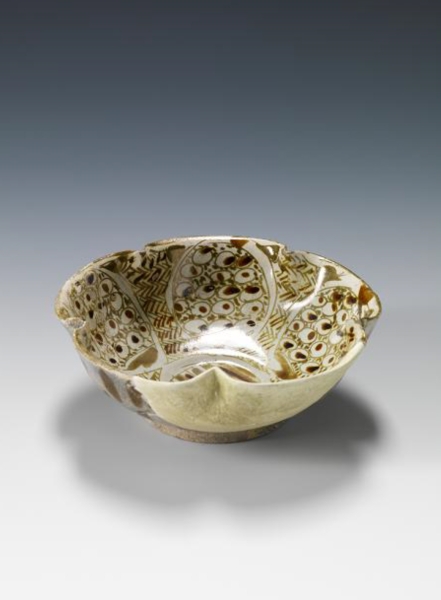
The Ancient Ceramic Bowl is an archaeological artifact made of metallic-luster ceramic. It features a wide basin, a foliated rim, and a flat circular base. The exterior surface is adorned with longitudinal and transverse lines, while the interior surface displays geometric and botanical motifs. The bowl was selected to be part of the Archaeological Masterpieces Through the Ages Exhibition, held at the Louvre Museum in Paris, the capital of France, in 2010.
History of the ceramic bowl
The ceramic bowl dates back to the Islamic period, during the Abbasid era, and was used for serving food. It was discovered in al-Rabatha Historical Area, one of the significant archaeological sites along the Hajj route from Kufa to Makkah al-Mukarramah. The site is located approximately two hundred km east of al-Madinah al-Munawwarah, along the western edge of the Hejaz Mountains. This discovery resulted from archaeological survey and excavation efforts conducted by the antiquities and museums sector in Saudi Arabia over the years, as part of the findings of Saudi archaeologists and scientific expeditions.
The ceramic bowl at the Louvre Museum
The ceramic bowl was registered under number 2294 and is preserved at the National Museum in Riyadh City. It was displayed as part of a diverse collection of archaeological discoveries and artifacts from Saudi Arabia in the Archaeological Masterpieces Through the Ages Exhibition, which was held at the Louvre Museum in Paris, the capital of France, in 2010. Afterward, it was displayed in several other exhibitions around the world. The exhibition featured three hundred authentic artifacts representing various materials and historical periods, originating from different provinces of the Kingdom of Saudi Arabia. These artifacts are categorized according to their historical sequence into three groups: prehistoric artifacts, pre-Islamic artifacts, and Islamic-era artifacts.
Dimensions of the ceramic bowl
Base diameter: Seven cm.
Height: 4.3 cm.
Rim diameter: 14.5 cm.
Thickness: Four mm.
Significance of the bowl
This glazed ceramic bowl demonstrates the precision and craftsmanship of Muslim artisans in crafting multicolored metallic-luster pottery (polychrome). This type of pottery is considered one of the finest and most sophisticated innovations of Muslim artisans across all ceramic styles. It emerged during the eighth and ninth centuries CE, spreading across Egypt, Iran, and Iraq, reflecting the strong cultural connections between the Arabian Peninsula and these lands.
Related quizzes
Related articles

